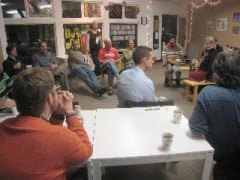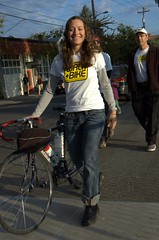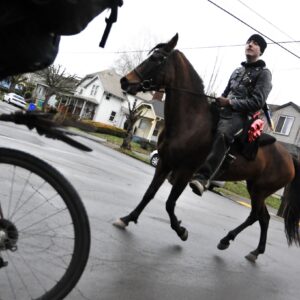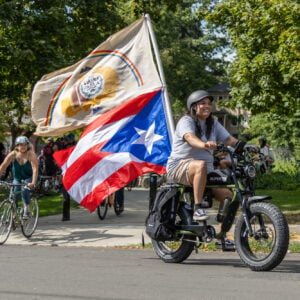This guest post is by Michael Andersen of Portland Afoot, a new “10-minute newsmagazine” and wiki about low-car life in Portland. Read more of his contributions to BikePortland here.
Will the walking movement ever be as successful as the bike movement?
Across the nation, biking advocates spent the last decade winning. And walking advocates have spent the last decade noticing.
Pedestrians may be “the club everyone belongs to but no one joins,” as a foot-traffic activist once lamented. But here in Portland, where the Willamette Pedestrian Coalition and Bicycle Transportation Alliance were incorporated within nine months of each other in 1991 and 1992, we tend to put a lot of faith in walking.
Our leaders are building the next citywide land-use plan around “20-minute neighborhoods” that would let you reach almost everything you need on foot in 20 minutes or less. Our Climate Action Plan aims to double the number of people walking to work, to 7.5 percent by 2050 – in other words, to make foot commutes about as common as bike commutes are now.

event last night to discuss the future
of Portland’s walking advocacy efforts.
(Photo: Naomi Bloom)
For the 20 or so people who braved Tuesday night’s storm to hear WPC Director Steph Routh share what she’d learned at a pair of recent national walking conferences, this is the walking movement’s destiny. But getting there, they said, will take allies. Here are a few interesting ideas floated Tuesday for building the alliances pedestrian advocates are looking for.
Local businesses: For shops, feet mean money
Good walking infrastructure, Routh said, is “like having a vacuum cleaner attached to people’s pockets. Money just comes flying out into the local economy.” In part that’s because shopping by foot is fun, and in part it’s because families don’t have to pour as much of their income into car loans and gasoline.
That’s music to a retailer’s ears – and to that retailer’s print shop, accountant, suppliers and everyone else with an interest in locally owned prosperity. As I found in reporting for Portland Afoot’s October issue, many retailers on the downtown transit mall are ambivalent or hostile to the car lanes on Fifth and Sixth avenues, but they’re universally in favor of boosting downtown foot traffic. That’s where the money’s at.
Emergency preparedness pros: Walkability = homeland security
It’s no joke. What do people need most in a natural or unnatural disaster? Access to clinics, to food, to transit. After a promising conversation at the conference, Routh predicts that some of the next great believers in walkability will be epidemiologists.
TriMet riders: Transit and walking, together at last?
Routh said she’s pleasantly surprised that bike and pedestrian advocates cooperate so well in Portland – but that she’s fascinated by the lack of coordination, at least nationally, between pedestrians and transit riders. Routh said she had great hopes for teaming up with OPAL, a local environmental justice group that began organizing Portland bus riders in January. Like WPC, OPAL endorsed the unsuccessful TriMet ballot measure that would have improved pedestrian access to 200 bus stops, but Routh has more than election campaigns in mind.
If the walking movement can ride the bike movement’s coattails, Routh said, “it’s our job to have coattails that transit ridership can ride on.”
Bikers: No retreat from the big streets
With the City of Portland devoting so much attention to its improved neighborhood greenway network, Routh said bike and pedestrian advocates may be tempted to think that low-traffic streets can solve all their transportation problems. That’d be a mistake, Routh said to widespread agreement. Big streets, after all, are where most of the best destinations are – not to mention the transit stops. As activist Alexis Grant pointed out, turning old highways like NE Sandy and SW Barbour into complete streets — with room for cars, buses, bikes and pedestrians to coexist — is something every active transportationist can unite behind.
Interested in pedestrian issues? Get ready for a media boomlet. Next Thursday the WPC will release one of its biggest projects ever, a comprehensive study of Portland’s pedestrian network called the Getting Around on Foot Action Plan. Routh says it’ll be a blueprint for WPC’s future.
To get a copy of their study, share your own ideas, or become a WPC member, email steph [at] wpcwalks [dot] org.
—The cover story of Portland Afoot’s November issue is about ordinary commuters with awesome obsessions. BikePortland readers in the metro area can subscribe for $10 a year with coupon code “bikeportland.” Email Michael at michael@portlandafoot.org.






Thanks to all who came, to Full Life Cafe for the hospitality, to our volunteers who made it happen, and to Jonathan and Michael for the great story.
I have to give the “vacuum cleaner” quote to Rodney Tolley of Walk21, though I certainly wish I were as witty as him.
Steph you are da bomb. <3 e
excellent summary of last night’s discussion. mike, thanks for reporting. and steph, big thanks for presenting.
These are great points. I would choose dog owners as the interest group to emulate over bicyclists, however; from my New York City perspective, dog owners have dedicated spaces (dog runs), dedicated hours (off-leash before 9 am in parks) and considerable public approval. Much better advocacy model than bicyclists, who struggle for scraps of street to ride on safely.
What if peds viewed cyclists the way we view motorists? And some do. Why is that?
When are they ever going to build a movie theater on the Interstate coridor? That would keep a lot of people in the neighborhood and reduce long trips